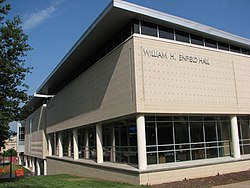|
University of Arkansas School of Law
The University of Arkansas School of Law is the law school of the University of Arkansas in Fayetteville, Arkansas, a state university. It has around 445 students enrolled in its Juris Doctor (J.D.) and Master of Law (LL.M) programs and is home to the nation's first LL.M in agricultural and food law program. The School of Law is one of two law schools in the state of Arkansas; the other is the William H. Bowen School of Law (University of Arkansas at Little Rock). According to the University of Arkansas School of Law's 2013 ABA-required disclosures, 68% of the Class of 2013 had obtained full-time, long-term, JD-required employment nine months after graduation.[8] History
The School of Law was founded in 1924. The founding dean was Julian Waterman, a Dumas, Arkansas native and University of Chicago Law School graduate who led the school through its first 19 years, until his death in 1943. The School met initially in the bottom floor of Old Main, and was approved by the American Bar Association two years later, in 1926. In 1927, the first class, consisting of ten students, graduated. Over the next several decades, as the law school grew in size, it moved to larger accommodations. The 1930s saw a move to the Chemistry Building just to the southeast of Old Main, and then into Waterman Hall, the first dedicated law school construction project, in the 1950s. The latter half of the 20th century saw additions added to Waterman Hall to form the Robert A. Leflar Law Center. In 1947, the law school offered admission to L. Clifford Davis, under conditions that would not allow him to be in any room at the same room as white students, including classrooms, restrooms, and the library. Davis chose to instead to take tuition money from the state to attend Howard University, in Washington, D.C.[9] On February 2, 1948, the University of Arkansas School of Law became the first Southern white university to accept an African-American student since Reconstruction. Silas H. Hunt, a World War II veteran who had been wounded in the Battle of the Bulge and following the conclusion of the war had completed an undergraduate degree in English at Arkansas Agricultural, Mechanical & Normal College applied to multiple law schools in 1947. He chose to seek entry at the Arkansas School of Law to challenge the system of racial segregation established in Arkansas at the time.[10] Accompanied by his attorney, Howard Flowers, Hunt met with the dean of the law school, Robert A. Leflar, who reviewed Hunt's application. Leflar was impressed and accepted Hunt's application to the law school. For a semester, Hunt attended the law school until succumbing to illness, and dying in a veteran's hospital on April 22, 1949, in Springfield, Missouri.[10] Following Hunt's successful entry into the law school, five more African-American students applied and were accepted into the law school: George Williford Boyce Haley, who went on to become a United States Ambassador to The Gambia; Wiley Branton, who served as dean at the Howard University School of Law; Jackie L. Shropshire; Chris Mercer; and George Howard, Jr., who later became the first black United States district court judge in Arkansas.[11] Collectively they are known as the "Six Pioneers." In June, 1951, Shropshire became the first to graduate. In 1958 Branton argued Cooper v. Aaron in front of the Supreme Court, which forced the integration of Little Rock Central High School.[12][13] Silas H. Hunt Hall, located adjacent to the Robert A. Leflar Law Center, honors Silas Hunt, in addition, to a historical marker in front of the law school. In 2007, a 64,000-square-foot (5,900 m2) addition to the Leflar Law Center was completed, expanding on the Young Law Library, as well as adding a coffee shop, four classrooms, a technologically equipped courtroom, and a formal entrance hall. Facilities The University of Arkansas School of Law is self-contained within the Robert A. Leflar Law Center on the campus of the University of Arkansas in Fayetteville, which is located in Washington County in Northwest Arkansas at the edge of the Ozarks.[citation needed] The law center is a square facility with four wings around a courtyard. It consists of approximately 64,000 square feet (5,900 m2), a courtroom, classrooms, and the Young Law Library. In addition to legal library resources, the Young Law Library includes a coffeeshop, computer lab and lounge area.[citation needed] Legal ClinicThe legal clinic of the law school has been in operation for more than forty years, offering free legal services to non-profits, small businesses, cooperatives, government agencies, and individuals unable to afford legal representation. The goal of the Legal Clinic, which offers the services of student attorneys, is firstly to train competently students in specific areas of legal practice encountered in every day law practice; and secondly to provide an opportunity for students to refine basic lawyering skills, such as counseling, interviewing and persuasive legal writing.[14] Clinics
The School of Law was the first school in the country to publish a student-edited legal journal devoted to the study of food law and its impact on society, the Journal of Food Law & Policy.[15] JournalsThe School of Law publishes four legal journals.:
Ranking and recognitionThe 2013 edition of U.S. News & World Report's "Best Law Schools" ranked the Arkansas School of Law as 68th overall.[20] US News also ranked Arkansas School of Law's legal writing and research 22nd in the country.[20] LawSchool100.com ranked the Arkansas School of Law as 88th overall in its 2010 ranking of law schools.[21] The Arkansas School of Law was also ranked 73rd overall according to the 2010 ranking by the AALS.[22] The ILRG ranked the Arkansas School of Law 71st overall in its 2009-2010 ranking of law schools.[23] The ILRG also has numerous other categories and ranks the Arkansas School of Law as the 62nd most selective law school, 65th for job placement before graduation, 55th for job placement after 9 months, 77th for best bar passer rates among first time takers, 98th when ranking the school versus the state average for bar passage rates and 72nd for student to faculty ratio.[24][25][26][27] Law & Politics' 2010 ranking of law schools ranked the Arkansas School of Law 139th overall.[28] Leiter's ranking of most desirable law schools lists Arkansas as the 54th most desirable law school in the country.[29][30] Law.com ranks Arkansas as 100th overall for best job placement and employment trends into "BigLaw".[31] In 2010, The Hylton Rankings place the Arkansas School of Law 86th overall among all law schools.[32] The Arkansas School of Law ranks 65th overall for percentage of class that obtain federal clerkships and 85th for total number of students obtaining federal clerkships.[33][34] Brian Koppen's Law School Advocacy ranks the Arkansas School of Law as 46th overall.[35] The 2010 National Moot Court rankings place the Arkansas School of Law at 13th overall.[36] Admissions
The University of Arkansas has LSAT scores that are similar to its peers and GPA ranges that exceed that of its peer schools.[37] The law school uses an index system to aid in the cutoff process that weights GPA and LSAT to reach a total index number. Applicants below the index will not fare as well as those with index scores above the index cutoff.[38] In 2010 the University of Arkansas school of law admitted 31% of applicants and since 2001 have averaged an acceptance rate of 34%.[39] Full-time enrollment in the most recent class was 137 students; the school of law only offers a full-time program of study.[39] The LSAT 75%/25% percentiles and medians were 159, 155, and 158 respectively. The GPA 75%/25% percentiles and medians were 3.73, 3.35, and 3.53 respectively.[39] Career placementAccording to the University of Arkansas School of Law's official 2013 ABA-required disclosures, 68.18% of the Class of 2013 had obtained full-time, long-term, JD-required employment nine months after graduation.[8] The University of Arkansas School of Law's Law School Transparency under-employment score is 15.9%, indicating the percentage of the Class of 2013 unemployed, pursuing an additional degree, or working in a non-professional, short-term, or part-time job nine months after graduation.[41] The University of Arkansas School of Law places graduates in all nine geographic regions according to the Association for Legal Career Professionals.[42] The school does place a majority in its home region, West South Central, with 71% of its graduates finding employment in region, and 53 percent of those staying in the West South Central region obtain employment in the state of Arkansas.[43] The most popular states for University of Arkansas School of Law graduates to find employment are in Arkansas, Texas, Missouri, Oklahoma, Georgia, Tennessee, and Mississippi.[44] The table to the right represents regional placement, with percentages, for University of Arkansas School of Law graduates.[45] The University of Arkansas has alumni that practice in all 50 states and the District of Columbia and six foreign nations. The ABA also collects data on placement and puts them into six major categories.[6] They are law firms, business and industry, government, judicial clerkships, academia, and public interest.[6] The University of Arkansas School of Law places a majority of its students into law firms, but significant portions of the class still obtain employment in other fields—business and industry, government, and judicial clerkships.[6] The table to the left represents the fields of placement, with percentages, for the most recent class from the University of Arkansas School of Law.[6] CostsThe total cost of attendance (indicating the cost of tuition, fees, and living expenses) at the University of Arkansas School of Law for the 2014-2015 academic year is $32,487.70.[46] The Law School Transparency estimated debt-financed cost of attendance for three years is $120,784.[47] People
Notable faculty
Notable alumni
References
External links |
||||||||||||||||||||||||||||||||||||||||||



